|
|
|
Sort Order |
|
|
|
Items / Page
|
|
|
|
|
|
|
| Srl | Item |
| 1 |
ID:
187756
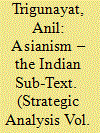

|
|
|
|
|
| Summary/Abstract |
Going by the economic growth patterns of China, India, Japan, South Korea and ASEAN countries with corresponding decline in the Western economic heft, it was often claimed that the 21st century will be the Asian Century. This might be in doubt due to the pandemic and geopolitical contestation between China and the US, where new faultlines are being drawn. Moreover, India and China being in a potential conflict zone, the dream of the Asian Century might have receded even further. But Asianism, given its intrinsic strength, has gone through its own evolution over the centuries, as the major Asian civilizations and cultures have interacted often seamlessly and occasionally competed with one another. Assimilation has often been the result. Ancient is intrinsic to the Asian thought, philosophy, and existence. Harmony with nature and a share-and-care attitude have been the hallmarks of the quest for eternal peace and co-existence. Yet, political Asianism has occasionally witnessed conflicts and wars in the name of supremacy and superiority which was hardly the real essence of the Asiatic value systems. The battle between the West and East accentuated them through the 19th and 20th centuries and the First and Second World Wars. The Western system moved forward, as Japan was defeated but eventually became part of the Western alliance system. India became independent and avoided the Cold War with the global governance architecture by virtue of her ancient mystical heritage and knowledge, new-found democratic credentials, a moral and principled stance reflected through her non-aligned approaches and pragmatic emphasis on peace and development for one-sixth of humanity, thereby leading the newly-independent developing countries from Asia to Africa, from the clutches of colonialism. This has provided India with an authoritative international voice of reason. And this is what will combine her software, powered by the civilizational heritage and universality of her cultural ethos, to enhance and extend her soft power appeal which is the subtext of her very existence.
|
|
|
|
|
|
|
|
|
|
|
|
|
|
|
|
| 2 |
ID:
187753


|
|
|
|
|
| Summary/Abstract |
In this article, I seek to understand the pre-European diversity of Asia as a recoverable ideal for a new Asianism, one that takes cosmopolitanism, plurality, and the concrete presence of the Other seriously, as modes of ‘reimperializing’ Asia based on Asian traditions of moral and cultural imagination. This pre-European diversity, rooted in the relational, inter-communal, and unfolding identity of the human person, is a new way of seeing Asia as ‘one’—the one, dynamic self, unbounded by nationalist or ideological constraints, on which a re-formation of social and political arrangements can and must be predicated.
|
|
|
|
|
|
|
|
|
|
|
|
|
|
|
|
| 3 |
ID:
111636
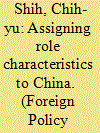

|
|
|
|
|
| Publication |
2012.
|
| Summary/Abstract |
This paper distinguishes and integrates national identity and national image through a deep role analysis. It argues that the meaning of China's rising rests upon the views of those who evaluate China's role playing. This role analysis mediates between international relations and Chinese foreign policy. It also mediates between China watchers and their China. The two dimensions of role-role taking and role making-generate four different discursive approaches to interpreting the rise of China, each in its own way associated with the affects of opportunity and threat. They are "nation state,""civilization,""Tianxia," and "Asianism." In response to the external view on the rise of China, Chinese narrators often take the Tianxia and nation state approaches as components of their conception of national role. These conceptions mediated by role-making and role-taking, evolve into four possible strategic focuses-national interests, imperialism, sovereignty and center-periphery. While this last strategic focus on role-taking has recently attracted enthusiastic response in China, it has been re-appropriated by social science concepts such as soft power and social capital that assume an egoistic role-making China is on the move.
|
|
|
|
|
|
|
|
|
|
|
|
|
|
|
|
| 4 |
ID:
091190
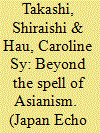

|
|
|
|
|
| Summary/Abstract |
Asianism had two major features. One was that it took modern Western Europe as a single, coherent civilization and criticized the double standard represented by the claim of universality for the Eurocentric world order and its exlusiveness in practice (with the
|
|
|
|
|
|
|
|
|
|
|
|
|
|
|
|
| 5 |
ID:
128888
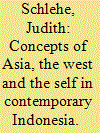

|
|
|
|
|
| Publication |
2013.
|
| Summary/Abstract |
This paper explores the imaginations of Asia, the West and various self-concepts in contemporary, post-Reformasi Indonesia. Departing from a problematization of the underlying concepts in recent social science literature, the author asks how Indonesians construct their moral order and their sense of Self, 'Asia' or 'the East' by constructing a Western counterpart. This question is traced with respect to various religious and spiritual orientations and to Indonesian popular culture. Finally, relocated orientations towards other imagined centres in the Global South and East are considered as potential indicators of an increasingly decentred world. The study is grounded in empirical fieldwork with people from various walks of life in different regions of Indonesia.
|
|
|
|
|
|
|
|
|
|
|
|
|
|
|
|
| 6 |
ID:
075791
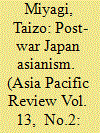

|
|
|
|
|
|
|
|